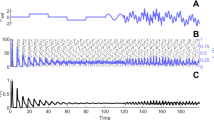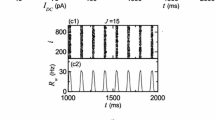Abstract
We study the dynamics of a pair of intrinsically oscillating leaky integrate-and-fire neurons (identical and noise-free) connected by combinations of electrical and inhibitory coupling. We use the theory of weakly coupled oscillators to examine how synchronization patterns are influenced by cellular properties (intrinsic frequency and the strength of spikes) and coupling parameters (speed of synapses and coupling strengths). We find that, when inhibitory synapses are fast and the electrotonic effect of the suprathreshold portion of the spike is large, increasing the strength of weak electrical coupling promotes synchrony. Conversely, when inhibitory synapses are slow and the electrotonic effect of the suprathreshold portion of the spike is small, increasing the strength of weak electrical coupling promotes antisynchrony (see Fig. 10). Furthermore, our results indicate that, given a fixed total coupling strength, either electrical coupling alone or inhibition alone is better at enhancing neural synchrony than a combination of electrical and inhibitory coupling. We also show that these results extend to moderate coupling strengths.
Similar content being viewed by others
References
Alvarez VA, Chow CC, VanBockstaele EJ, Williams JT (2002) Frequency-dependent synchrony in the locus ceruleus: Role of electrical coupling. Proc. Natl. Acad. Sci. USA 99: 4032-4036.
Amitai Y, Gibson JR, Beierlein M, Patrick SL, Ho AM, Connors BW, Golumb D (2002) Spatial dimensions of electrically coupled networks of interneurons in neocortex. J. Neurosci. 22: 4142-4152.
Beierlein M, Gibson JR, Connors BW (2000) A network of electrically coupled interneurons drives synchronized inhibition in neocortex. Nat. Neurosci. 3: 904-910.
Bem T, LeFeuvre Y, Simmers J, Meyrand P (2002) Electrical coupling can prevent expression of adult-like properties in an embryonic neural circuit. J. Neurophysiol. 87: 538-547.
Benardo LS (1997) Recruitment of GABAergic inhibition and synchronization of inhibitory interneurons in rat neocortex. J. Neurophysiol. 77: 3134-3144.
Bressloff PC, Coombes S (1997) Synchrony in an array of integrate-and-fire neurons with dendritic structure. Phys. Rev. Lett. 78: 4665-4668.
Bressloff PC, Coombes S (2000) A dynamical theory of spike train transitions in networks of integrate-and-fire oscillators. SIAM J. Appl. Math. 60: 820-841.
Buhl EH, Tamas G, Fisahn A (1998) Cholinergic activation and tonic excitation induce persistent gamma oscillations in mouse somatosensory cortex in vitro. J. Physiol. (Lond) 513: 117-126.
Buzsáki G, Chrobak JJ (1995) Temporal structure in spatially organized neuronal ensembles: A role for interneuronal networks. Curr. Opin. Neurobiol. 5: 504-510.
Chow CC (1998) Phase-locking in weakly heterogeneous neuronal networks. Physica D 118: 343-370.
Chow CC, Kopell N (2000) Dynamics of spiking neurons with electrical coupling. Neural Comp. 12: 1643-1678.
Crook SM, Ermentrout GB, Bower JM (1998) Dendritic and synaptic effects in systems of coupled cortical oscillators. J. Comput. Neurosci. 5: 315-329.
Erisir A, Lau D, Rudy B, Leonard S (1999) Function of specific K + channels in sustained high-frequency firing of fast-spiking neocortical cells. J. Neurophysiol. 82: 2476-2489.
Ermentrout GB (1996) Type I Membranes, phase resetting curves and synchrony. Neural Comp. 8: 979-1001.
Ermentrout GB, Kleinfeld D (2001) Traveling electrical waves in cortex: Insights from phase dynamics and speculation on computational role. Neuron 29: 33-44.
Ermentrout GB, Kopell N (1991) Multiple pulse interation and averaging in coupled neural oscillators. J. Math. Biol. 29: 195-217.
Ermentrout GB, Kopell N (1998) Fine structure of neural spiking and synchronization in the presence of conduction delays. Proc. Natl. Acad. Sci. USA 95: 1259-1264.
Fisahn A, Pike F, Buhl EH, Paulsen O (1998) Cholinergic induction of network oscillations at 40 Hz in the hippocampus in vitro. Nature 394: 186-189.
Galarreta M, Hestrin S (1999) A network of fast-spiking cells in the neocortex connected by electrical synapses. Nature 402: 72-75.
Galarreta M, Hestrin S (2001a) Electrical synapses between GABAreleasing interneurons. Nat. Rev. Neurosci. 2: 425-433.
Galarreta M, Hestrin S (2001b) Spike transmission and synchrony detection in networks of GABAergic interneurons. Science 292: 2295-2299.
Gerstner W (1995) Time structure of the activity in neural network models. Phys. Rev. E 51: 738-758.
Gibson JR, Beierlein M, Connors BW (1999) Two networks of electrically coupled inhibitory neurons in neocortex. Nature 402: 75-79.
Golomb D, Hansel D, Mato G (2001) Mechanisms of synchrony of neural activity in large networks. In: F Moss, S Gielen, eds. Handbook of Biological Physics, Vol. 4: Neuro-Informatics and Neural Modelling. Elsevier, Amsterdam. pp. 887-968.
Golomb D, Wang X, Rinzel J (1994) Synchronization properties of spindle oscillations in a thalamic reticular nucleus model. J. Neurophysiol. 72: 1109-1126.
Grannan ER, Kleinfeld D, Sompolinsky H (1993) Stimulus dependent synchronization of neuronal assemblies. Neural Comp. 5: 550-569.
Gupta A, Wang Y, Markram H (2000) Organization principles for a diversity of GABAergic interneurons and synapses in the neocortex. Science 287: 273-278.
Han SK, Kurrer C, Kuramoto Y (1995) Dephasing and bursting in coupled neural oscillators. Phys. Rev. Lett. 75: 3190-3193.
Hansel D, Mato G, Meunier C. (1995) Synchrony in excitatory neural networks. Neural Comp. 7: 307-337.
Kopell N (1988) Toward a theory of modeling central pattern generators. In: A Cohen, ed. Neural Control of Rhythmic Movements in Vertebrates. John Wiley, New York. pp. 396-413.
Kuramoto Y (1984) Chemical Oscillations, Waves, and Turbulence. Springer-Verlag, Berlin.
Lewis TJ, Gibson JR, Connors BW, Rinzel J (2001) Dynamics of neurons connected by inhibitory and electrical synapses. Society for Neuroscience Abstract 504: 16.
McBain CJ, Fisahn A (2001) Interneurons unbound. Nat. Rev. Neurosci. 2: 11-23.
Michelson HB, Wong RK (1994) Synchronization of inhibitory neurones in the guinea-pig hippocampus in vitro. J. Physiol. (Lond) 92: 35-45.
Neltner L, Hansel D, Mato G, Meunier C (2000) Synchrony in hetergeneous networks of spiking neurons. Neural Comp. 12: 1607-1641.
Oviedo H, Reyes AD (2002) Boosting of neuronal firing evoked with asynchronous and synchronous inputs in the dendrite. Nat. Neurosci. 5: 261-266.
Rinzel J, Ermentrout GB (1998) Analysis of neural excitability and oscillations. In: C Koch, I Segev, eds. Methods in Neuronal Modeling: From Synapse to Networks. MIT Press, Cambridge, MA. pp. 251-292.
Ritz R, Sejnowski TJ (1997) Synchronous oscillatory activity in sensory systems: New vistas on mechanism. Curr. Opin. Neurobiol. 7: 536-546.
Sherman A, Rinzel J (1994) Rhythmogenic effects of weak electrotonic coupling in neuronal models. Proc. Natl. Acad. Sci. USA 89: 2471-2474.
Skinner FK, Zhang Y, Velazquez JLP, Carlen PL (1999) Bursting in inhibitory interneuronal networks: A role for gap-junctional coupling. J. Neurophysiol. 81: 1274-1283.
Stuart G, Sakmann B (1995) Amplification of EPSPs by axosomatic sodium channels in neocortical pyramidal neurons. Neuron 15: 1065-1076.
Swadlow HA, Beloozerova IN, Sirota MG (1998) Sharp, local synchrony among putative feed-forward inhibitory interneurons of rabbit somatosensory cortex. J. Neurophysiol. 79: 567-582.
Tamás G, Buhl EH, Lörinz A, Somogyi P (2000) Proximally targeted GABAergic synapses and gap junctions synchronize cortical interneurons. Nat. Neurosci. 3: 366-371.
Traub RD (1995) Model of synchronized population bursts in electrically coupled interneurons containing active dendrites. J. Comput. Neurosci. 2: 283-289.
Traub RD, Kopell N, Bibbig A, Buhl EH, LeBeau FEN, Whittington MA (2001) Gap junctions between interneuron dendrites can enhance synchrony of gamma oscillations in distibuted networks. J. Neurosci. 21: 9478-9488.
Usher M, Cohen JD, Servan-Schreiber D, Rajkowski J, Aston-Jones G (1999) The role of Locus Coeruleus in the regulation of cognitive performance. Science 283: 549-554.
van Vreeswijk C, Abbott LF, Ermentrout GB (1994) When inhibition not excitation synchronizes neural firing. J. Comput. Neurosci. 1: 313-321.
Various (1999) Reviews on the binding problem. Neuron 24: 7-125.
Wang X, Buzsáki G (1996) Gamma oscillations by synaptic inhibition in an interneuronal network model. J. Neurosci. 16: 6402-6413.
Wang X, Rinzel J (1992) Alternating and synchronous rhythms in reciprocally inhibitory model neurons. Neural Comp. 4: 84-97.
White JA, Chow CC, Ritt J, Soto-Trevino C, Kopell N (1998) Synchronization and oscillatory dynamics in heterogeneous, mutually inhibitory neurons. J. Comput. Neurosci. 5: 5-16.
Whittington MA, Standford IM, Traub RD, Jefferys JG (1997) Spatiotemporal patterns of gamma frequency oscillations tetanically induced in the rat hippocampual slice. J. Physiol. (Lond) 502: 591-602.
Whittington MA, Traub RD, Jefferys JG (1995) Synchronized oscillations in interneuron networks driven by metabotropic glutamate receptor activation. Nature 373: 612-615.
Ylinen A, Bragin A, Nádasdy Z, Jandó G, Szabó I, Sik A, Buzsáki G (1995) Sharp wave-associated high-frequency oscillations (200 Hz) in the intact hippocampus: Network and intracellular mechanisms. J. Neurosci. 15: 30-46.
Author information
Authors and Affiliations
Rights and permissions
About this article
Cite this article
Lewis, T.J., Rinzel, J. Dynamics of Spiking Neurons Connected by Both Inhibitory and Electrical Coupling. J Comput Neurosci 14, 283–309 (2003). https://doi.org/10.1023/A:1023265027714
Issue Date:
DOI: https://doi.org/10.1023/A:1023265027714




